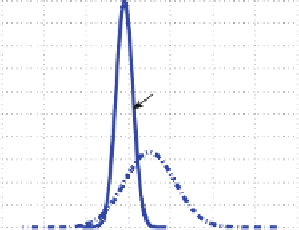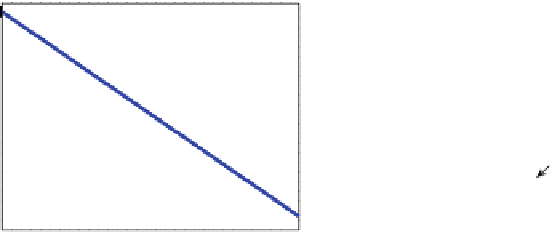Digital Signal Processing Reference
In-Depth Information
a
b
LIN
EA
R TR
A
NSFO
R
MATIO
N
: Y=−3X+2
LINEAR TRANSFORMATION of NORMAL R.V.X
100
0.2
Y=−3X+2,
80
0.18
0.16
60
40
0.14
20
0.12
INPUT R.V. X
mX=−1, VA=4
0
0.1
−20
0.08
OUTPUT R. V. Y.
0.06
−40
mY=5; VA=36
−60
0.04
−80
0.02
0
−100
−30
−20
−10
0
10
20
30
−30
−20
−10
0
10
20
30
40
x,y
X
Fig. 4.7
Linear transformation of a normal random variable. (
a
) Linear transformation. (
b
) Input
and output PDFs
Figure
4.7a
shows the transformation and Fig.
4.7b
shows the input and the
transformed PDFs.
4.3.1.2 Nonlinear Transformation
We use the expression (
2.138
) to illustrate that the nonlinear monotone transforma-
tion of a normal variable does not result in a normal variable.
Example 4.3.2
In this example, consider the logarithmic transformation
Y ¼
e
X
(4.77)
e
ð
ln
y
m
X
Þ
2
f
X
ð
x
Þ
d
d
x
1
2
p
2
s
2
X
f
Y
ðyÞ ¼
¼
p
y>
0
(4.78)
;
x¼
ln
y
s
X
y
The obtained PDF is lognormal and will be examined in more detail in the next
chapter. The transformation as well as input and output PDFs are shown in
Fig.
4.8a
, b, respectively.
4.3.2 Nonmonotone Transformation
The nonmonotone transformation of a normal random variable changes the variable
such that the resulting variable is not normal, as shown in the following example.
Example 4.3.3
We consider the absolute value of the normal variable with a zero
mean value and a variance of 1.
































































Search WWH ::

Custom Search